Beaver is a furry animal with a broad, paddlelike tail. Beavers have strong jaws and front teeth that they use to cut down trees. They eat the bark of trees and use the branches to build dams and lodges (homes) in the water. Beavers typically appear busy working on their dams or lodges. For this reason, people often call a hard-working person an “eager beaver” or say that the person is “busy as a beaver.”
More beavers live in the United States and Canada than anywhere else in the world. Beavers also inhabit Asia and Europe. They live in rivers, streams, and freshwater lakes near woodlands. Though they waddle clumsily on land, beavers make excellent swimmers. A beaver can swim underwater for 1/2 mile (0.8 kilometer), and hold its breath for 15 minutes.
Historically, people have hunted beavers for fur, meat, and medicinal products. Clothing manufacturers use beaver skins to make fur coats and to trim the collars and cuffs of cloth coats. Manufacturers also create a cloth called felt by pressing beaver fur together with other kinds of fur. People once used castoreum, an oily substance from the scent glands of beavers, to treat sores, ulcers, and intestinal cramps. Castoreum still serves as an ingredient in some perfumes.
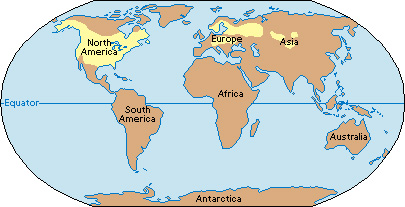
Before European settlement of North America, an estimated 60 million to 400 million beavers lived there. However, from the late 1500’s through the 1800’s, people hunted beavers more aggressively than probably any other animal on the continent. The pioneers and Native Americans ate beaver meat, used the fur, and traded the pelts for needed items. Trading companies bought the pelts from trappers and shipped the fur to clothiers throughout the world. The animals became so valuable that by 1900, fur trappers had nearly eliminated the beaver population. Captive breeding and release, protective laws, and a decline in the popularity of beaver-skin products have led to the animal’s recovery. Today, the beaver population in the United States and Canada continues to grow despite the trapping of hundreds of thousands of beavers each year.
The body of a beaver
Beavers rank as the world’s second largest rodents (gnawing animals). Only South America’s capybara grows larger. North American beavers measure 3 to 4 feet (90 to 120 centimeters) long, including the tail, and weigh from 35 to 70 pounds (16 to 32 kilograms). Beavers have more massive skeletons than do other similar-sized mammals.
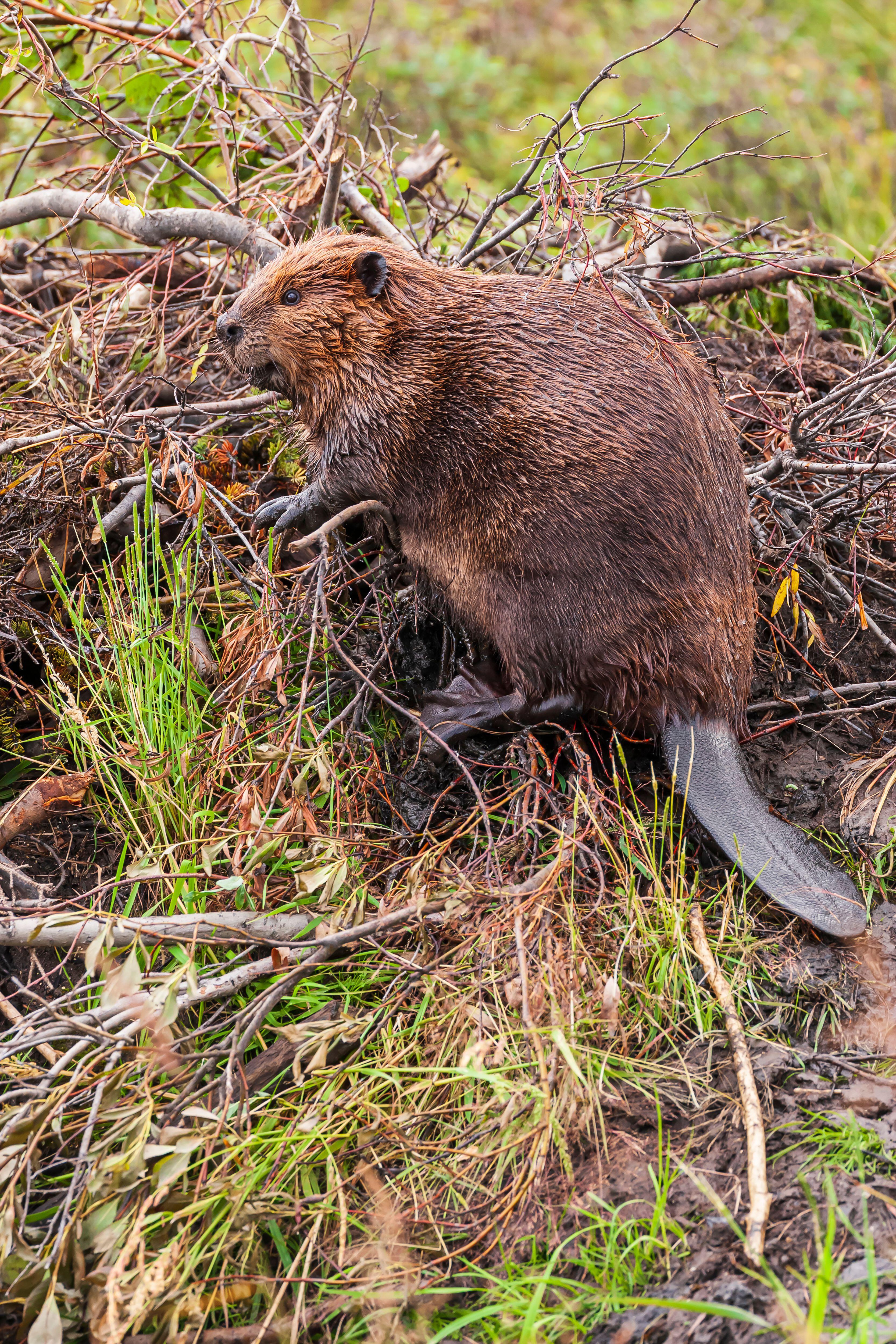
Thousands of years ago, some North American beavers grew to about 71/2 feet (2.3 meters) long—nearly as big as grizzly bears. Scientists have not determined why these huge beavers died out.
Head.
The broad head of the beaver has large and powerful jaws. Its rounded ears and small nostrils can close tightly to keep water out. A beaver has three eyelids on each eye. Two outer eyelids—one upper and one lower—enable the eye to close. A transparent inner eyelid slides down over the eye, helping the beaver to see underwater. On land, the inner eyelid protects the animal’s eyes from wood chips when it cuts trees. Beavers do not see well at a distance and depend on their keen hearing and sense of smell to detect danger.
Teeth.
A beaver has 20 teeth—4 strong, curved front teeth for gnawing and 16 back teeth with flat, rough edges for chewing. The front teeth, called incisors, feature a hard, bright orange outer covering. The back part of the incisors consists of a much softer substance. When a beaver gnaws, the back part of its incisors wears down much faster than the front part. As a result, these teeth take on a sharp, chisellike edge. The incisors never wear out because they continue to grow throughout the animal’s life. The back teeth stop growing when the beaver is about 2 years old.
Large gaps exist between the beaver’s incisors and its back teeth. Flaps of skin, one on each side of the mouth, fold inward and meet behind the incisors. These skin flaps seal off the back of the mouth. They enable the animal to gnaw wood on land or in the water without getting splinters or water in its throat or windpipe. The flaps open when the beaver swallows or breathes.
Feet.
The short legs of the beaver end in black feet covered in tough skin with little hair. Each front paw has five toes with long, thick claws. A beaver uses these claws to dig up mud for its dam and to unearth the roots of bushes, trees, and water plants for food. When swimming, the beaver usually makes tight fists of its front paws and holds them against its chest.
A beaver’s back feet are larger than its front ones and may measure 6 to 7 inches (15 to 18 centimeters) long. These webbed feet serve as flippers and help to make the animal a powerful swimmer and diver. The beaver uses two split claws on each hind foot to comb its fur.
Tail.
A beaver’s stiff, flat tail ranks among its most interesting features. The tail measures 9 to 12 inches (23 to 30 centimeters) long, 5 to 7 inches (13 to 18 centimeters) wide, and 3/4 inch (2 centimeters) thick. The small part of the tail near the beaver’s body has the same kind of fur as the body. Black, scaly skin with a few stiff hairs covers the rest of the tail. A beaver uses its tail to steer when it swims and as a prop when it stands on its hind legs to eat or cut trees. A beaver slaps its tail on the water to make a loud noise that warns other beavers of danger.
Fur.
The fur of a beaver may be black, chestnut, dark brown, or yellowish-brown. But it looks black when wet. A beaver’s coat consists of two kinds of fur: (1) short, soft underfur and (2) longer, heavier guard hairs. The guard hairs lie over the underfur and protect it. The underfur traps air and holds it close to the animal’s skin. The trapped air acts as a protective layer of insulation that keeps the beaver warm, even in icy water.
The life of a beaver
Beavers are monogamous animals—that is, they mate with only one partner. However, if that partner dies, the beaver will find a new mate. A beaver family consists of the adult male and female pair along with any newborn young and adult offspring from previous years. The entire family can number in the teens and usually includes 4 to 6 adults. All of the adults participate in building the dam and lodge and in defending the territory.
A beaver marks its territory with numerous castors, small piles of mud mixed with the beaver’s scent. The castors inform beavers from outside a family group that a territory is occupied and defended. The odor also enables individuals within a family group to recognize which family members have recently visited that spot.
Beavers live 10 to 15 years on average, and up to 20 years if protected from trapping. Bears, bobcats, coyotes, foxes, golden eagles, lynxes, mountain lions, wolves, and wolverines hunt beavers. Beavers avoid these animals by keeping watch as a group, taking refuge underwater, and coming out mostly at night to work or search for food.
Raising young.
A female beaver carries her young inside her body for about three months before birth. She typically bears two to four young at a time but may have as many as nine. Most kits (young beavers) are born in April or May. Newborn kits measure about 15 inches (38 centimeters) long, including a tail about 31/2 inches (9 centimeters) long. They weigh 1/2 to 11/2 pounds (0.2 to 0.7 kilogram). At birth, a kit has soft, fluffy fur. Its eyes are open, and it can walk and swim. 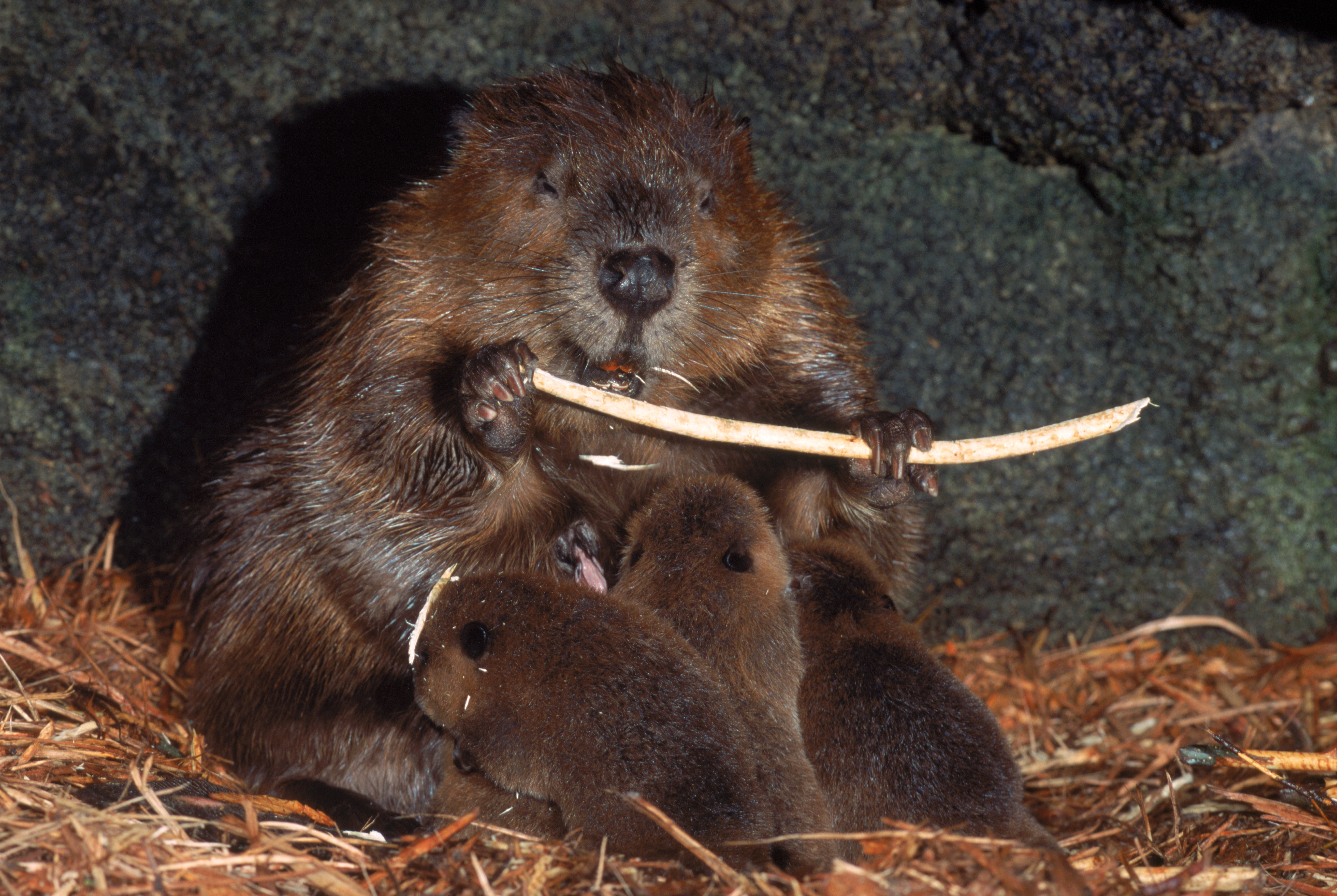
The young usually live with their parents for about two years and then leave the family group. Occasionally, fighting occurs within family groups when the adults must encourage their 2-year-old offspring to leave.
Finding food.
Beavers eat the bark, twigs, leaves, and roots of trees and shrubs. Their favorite trees include poplars, especially aspens and cottonwoods, and willow trees. One acre (0.4 hectare) of poplars can support a family of six beavers for one to two years. Beavers also eat water plants, including cattail roots and the roots and tender sprouts of water lilies.
Beavers store food for winter use. They anchor logs and branches underwater in a hidden place called a cache. In winter, beavers swim under the ice and bring food from the cache back to their nearby lodge to eat.
Cutting down trees.
Beavers typically work alone to cut down trees, but sometimes several family members work together. The animals use their strong front teeth to fell a tree, remove its branches, and peel off the bark. To cut a tree, a beaver stands on its hind legs and uses its tail as a prop. It places its front paws on the tree trunk and turns its head sideways. The beaver bites the trunk to make a cut in it. Then the animal makes another cut farther down on the trunk and takes several bites at both cuts to make them deeper. The beaver makes the cuts farther apart on large trees than on small ones. 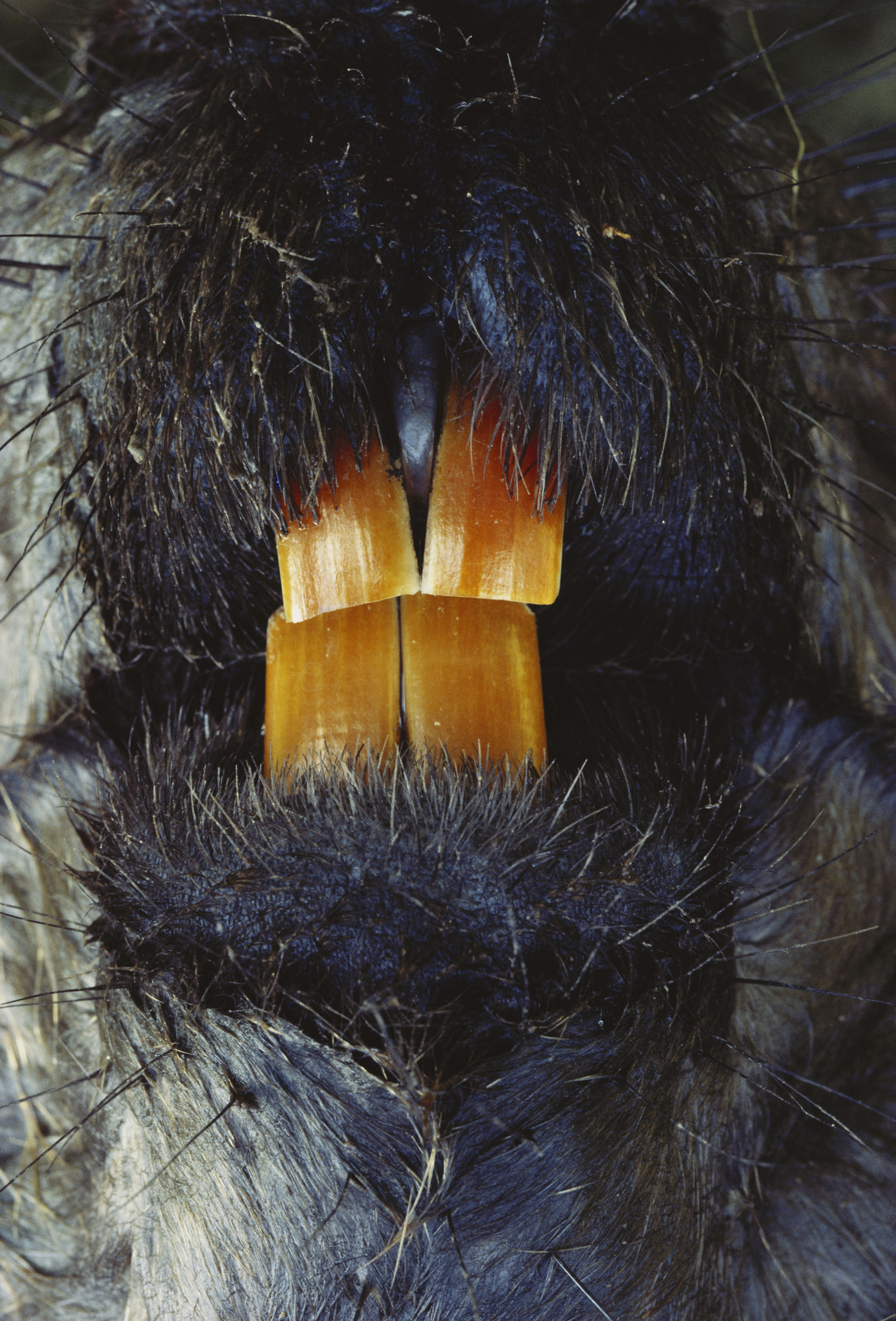
With its teeth, the animal gnaws and tears out pieces of wood between the cuts. Beavers usually cut the wood all the way around a tree trunk, but they sometimes cut through the trunk from one side. A beaver will cut until the trunk starts to break and then shuffle to safety, often in nearby water. It waits there to be sure that the noise of the falling tree has not attracted any predators. Then the beaver goes back to work on the felled tree.
First the animal gnaws the branches off the tree. Then it carries, drags, pulls, pushes, or rolls the log into the water. The beaver eats some branches immediately and stores others deep underwater for food in winter. The beaver may also use the branches to enlarge or repair the dam and the lodge.
Building dams and canals.
An entire beaver family participates in building a dam. The dam backs up the flow of water from a stream, which results in the formation of a small pond. The pond provides the beavers with access to food and protection from predators on land. Beavers build their dam so that the top rises above the water. They maintain the dam in good condition for many years. Most beavers that live in lakes do not build dams, but some build dams across the outlets of small lakes. Some dams extend over 1,000 feet (300 meters).
Beaver dams consist of logs, branches, and rocks plastered together with mud. Stones and mud make up the base of the dam. The beavers add sticks and small logs to the base. They strengthen the dam on one side by placing the logs so that the tips lean in the same direction that the water flows. The beavers plaster the tops and sides of these logs with more mud, stones, and wet plants. On the opposite side of the dam, the beavers push the ends of additional sticks and small logs into the bottom of the stream. These sticks and logs lean against the stream’s current and help to stabilize the dam. Beavers do most of this work with their front teeth and front paws. However, they also bring sticks and mud from the river bottom by clutching the material against their chest between their chin and front legs.
Sometimes beavers dig canals that enable them to move sticks and logs to their dam or lodge more easily and quickly. The canals measure 12 to 18 inches (30 to 46 centimeters) deep, 18 to 24 inches (46 to 61 centimeters) wide, and may reach over 700 feet (200 meters). They may extend from a wooded area to a pond or cut across a peninsula.
Building lodges.
A beaver lodge resembles a wigwam. Beavers build a lodge with the same materials and in much the same way they do a dam. Most lodges stand in the water, though some may stand near the riverbank. The top of most lodges rises 3 to 6 feet (90 to 180 centimeters) above the water. Each lodge has several underwater openings leading to an inside chamber. The chamber floor sits 4 to 6 inches (10 to 15 centimeters) above the water. Here, the beavers give birth, raise their young, and huddle together to stay warm, dry, and safe. Tiny holes between the ceiling branches let in fresh air.
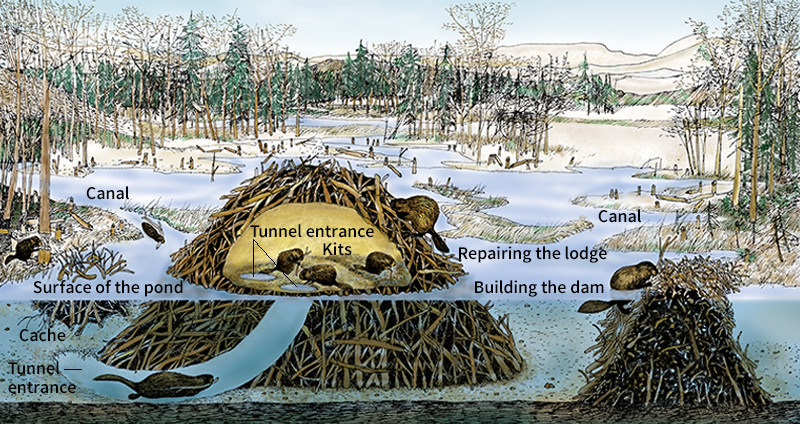
The size of the lodge depends on the size of the beaver family and the length of time it has lived there. Beavers enlarge and repair their lodge as long as they live in it. They abandon their lodge only if the water dries up or they have eaten all of the area’s food.
Beavers that live in large lakes or in swift rivers may dig dens in the banks. These dens, like the lodges, have underwater entrances and tunnels leading to a central, dry living chamber.
Loading the player...Beaver pup climbing on a dam
